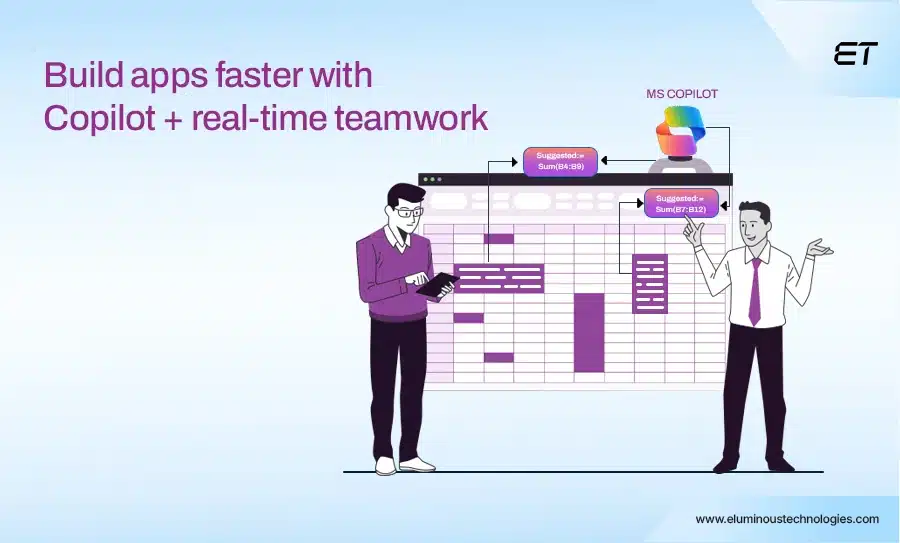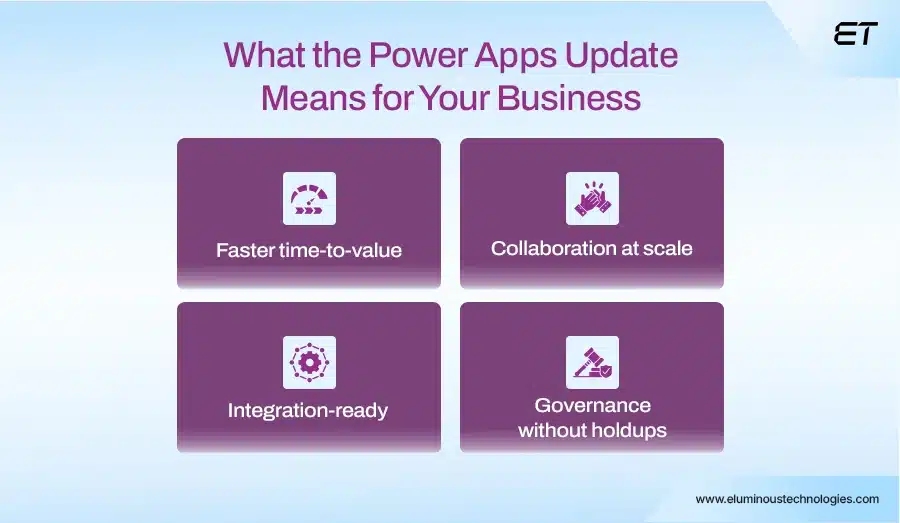
The Latest Power Apps Update You Should Know About
Virgin Atlantic, Heathrow Airport, and G&J Pepsi Bottling are just a few of the high-profile names using Microsoft Power Apps. With the proper knowledge or the right team, even you could join their ranks without heavy coding.
The reason is simple: this low-code platform enhances your development pace and enables you to scale efficiently. You can also integrate with existing Microsoft ecosystems, such as Dataverse, Teams, and Azure. Gartner predicts that by 2026, 75% of new apps will be built with low-code tools.
All these aspects point to one thing – keeping up with the latest Power Apps update is vital.
In this blog, we’ll focus on the 2025 additions, highlighting everything you need to know to plan your next project smartly.
Looking for veteran Power Apps experts? Get developers with over 15 years of Microsoft experience within 48 hours.
Power Apps Update 2025: Key Features and Context You Can’t Ignore

The latest update offers a range of interesting features. Here’s a glance at the basic info:
- Release Wave 1: April 2025 – September 2025
- Release Wave 2: October 2025 – March 2026
- What You Get in Wave 1: Enhanced Component Properties, AI-powered Copilot enhancements, and improved governance tools
- What You Get in Wave 2: Custom Copilot agents and enhanced automation features
Here are the main facets to consider:
- Enhanced app building
- Smarter AI and collaboration tools
- Governance and integration
Let’s cover the three key additions in depth.
1. Enhanced App Building and Reusability

If you’re tired of rebuilding the same logic over and over, this part of the Power Apps update is going to feel like a breath of fresh air.
At the core of this update is Enhanced Component Properties (ECPs). Unlike regular components, ECPs can now carry their own logic and functions. This aspect enables you to reuse them across multiple apps without needing to rewrite code.
Example: You have a custom approval workflow that you use in five different applications. Before ECPs, you’d have to copy and paste logic and tweak it. With ECPs, you can define that workflow once inside a component, and then plug it into any app. Just change it once in the component library, and every app using it gets the improvement automatically.
Another subtle but significant change is the renaming of UntypedObject to Dynamic. Now your components handle dynamic data types more intuitively, making it easier to work with multiple data sources and integrations.
Practical impact for businesses:
- Faster development
- Consistency
- Reduced errors
- Easier maintenance
In short, this aspect of the update allows you to run multiple apps across teams. This way, you can reduce development time while improving quality and scalability.
Here’s your go-to resource to understand the different types of Power Apps.
2. Smarter AI and Collaboration Tools

This Power Apps upgrade focuses on making apps smarter and easier to build together.
First, let’s talk AI. Microsoft continues to invest heavily in Copilot. With the 2025 wave, Copilot can now generate complex formulas and suggest controls by simply describing what you want to achieve.
Example: Instead of writing a formula to filter orders by customer region, you just type “Show me orders from North America above $5,000”, and Copilot generates the correct expression on the spot.
Collaboration also gets a substantial upgrade. Makers and pro-developers can now co-author apps in real-time. You can see edits, comments, and updates happening live. This aspect eliminates the “wait your turn” bottleneck where one person has to check in changes before another can continue.
Practical impact for businesses:
- AI reduces complexity: Non-technical users can build apps with fewer hurdles.
- Real-time co-authoring: Teams can iterate more efficiently without the chaos of version control.
- Cross-skill collaboration: Citizen developers and IT professionals can now work side by side effectively.
In short, this update makes Power Apps more like a collaborative AI-driven workshop.
Stuck while choosing the perfect collaboration tool? Explore our blog, which covers this concept and offers options ranging from GitHub to Confluence and beyond!
3. Governance and Integration

Every company that has scaled Power Apps knows this: building apps is fun, but governing them is where the real headache begins. Microsoft addresses this aspect with the Power Apps update.
The Governance improvements focus on giving admins and IT teams more control without slowing down app makers. For instance:
- Managed environments now come with expanded policies, so you can enforce rules for data usage, connectors, and app sharing at scale.
- Deeper environment analytics help IT spot unused or underperforming apps before they become clutter.
On the integration side, Power Apps tightens its handshake with the broader Microsoft ecosystem. You can expect smoother connections with Dataverse, Teams, and Dynamics 365.
Example: If your sales team uses a Power App linked to Dynamics 365, IT can now enforce connector policies. This way, sensitive customer data isn’t accidentally exposed via third-party apps. At the same time, developers can integrate external APIs without needing custom wrappers.
Practical impact for businesses:
- Better compliance without slowing down makers.
- Cleaner environments thanks to analytics-driven housekeeping.
- Seamless integrations that extend Power Apps beyond Microsoft-first use cases.
In short, this update strikes a balance between the freedom for creators and the peace of mind for IT.
What Does the Power Apps Update Mean for You

The Power Apps Update 2025 can facilitate you to rethink how you build, scale, and govern apps. Here’s the practical takeaway:
- Faster Time-to-Value: Enhanced Component Properties and smarter AI mean your teams can roll out apps quicker, reducing dependency on traditional IT cycles
- Collaboration at Scale: Real-time co-authoring and AI-assisted formula generation empower both citizen and pro developers
- Governance Without Bottlenecks: Managed environments and deeper analytics give IT teams confidence that apps stay compliant while makers move fast
- Integration-Ready: Tightened connections with Dataverse, Teams, and Dynamics 365 open doors for more complex workflows and enterprise-wide automation
In short, this Power Apps Update is strategic. Once you embrace these features, it’s possible to save time, reduce errors, and improve collaboration across departments.
Power Apps or Power Pages – Which is the right choice for you? Our blog answers this common low-code dilemma. (Bonus: Cheat Sheet Inside!)
Real-World Use Cases of the Power Apps Update
Reading about features is one thing, seeing them in action is another. Here are a few scenarios where the Power Apps Update 2025 can make a real difference:
| Business Scenario | How the Power Apps Update Helps | Key Benefits |
| HR Onboarding | Reusable onboarding modules with Enhanced Component Properties; Copilot generates approval flows automatically | Faster onboarding, fewer errors, scalable HR processes |
| Sales Approval Workflows | AI-assisted formula generation; real-time co-authoring for quick updates; governance ensures compliance | Quicker approvals, improved collaboration, secure processes |
| Field Service Inspections | Dynamic components and integration with Dataverse & Teams; real-time data submission | Real-time reporting, automated follow-ups, reduced manual work |
| Cross-Department Automation | Shared components and workflows across finance, marketing, and operations | Consistency across apps, reduced duplication, faster automation rollout |
Summing Up: Why This Power Apps Update Matters
The Power Apps Update 2025 is a strategic event in the low-code domain. From reusable components and AI-assisted formulas to real-time collaboration and enhanced governance, this update streamlines app development while maintaining IT control and oversight.
Using the latest Power Apps features, you can:
- Deliver apps faster without compromising quality
- Enable collaboration between citizen and professional developers
- Maintain compliance and security across environments
- Scale automation and integrations across departments
So, start exploring its features now. If you don’t have time, explore our Power Apps services and choose the one that meets your needs.
With more than 50 enterprise customers, our Power Apps team is equipped to start your project. Drop in your details and our expert will get back to you ASAP.
Frequently Asked Questions
1. What are the key features of the Power Apps Update 2025?
The Power Apps Update 2025 introduces Enhanced Component Properties (ECPs) for reusable logic. This update also includes AI-powered Copilot enhancements for formula suggestions, real-time co-authoring, and improved governance tools.
2. How does the update improve app building with AI?
AI enhancements in the 2025 update allow Copilot to generate formulas, suggest controls, and create app pages based on natural language instructions. This aspect can help both citizen and pro developers build apps faster and more accurately.
3. What business benefits does the Power Apps update offer?
The update enables faster app deployment, promotes collaboration across teams, and reduces errors through reusable components. It also ensures compliance with governance tools and simplifies integrations across Microsoft services.
4. What did the June 2025 update include?
The June 2025 update included Enhanced Component Properties, the renaming of UntypedObject to Dynamic, and AI Copilot enhancements for intelligent suggestions. It also added features for improved design-time testing and audit improvements for choice fields.





